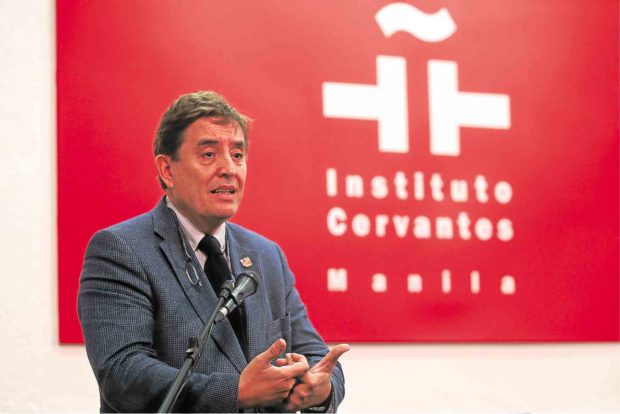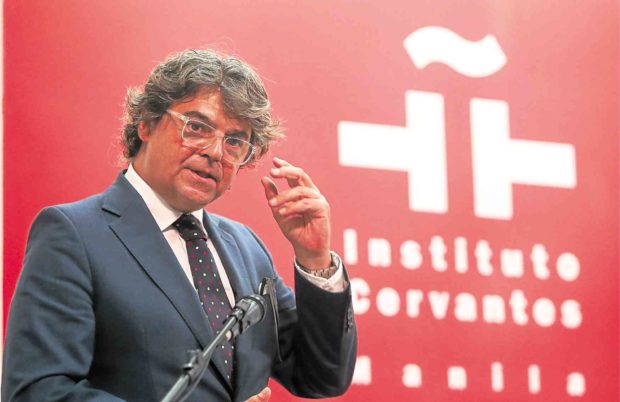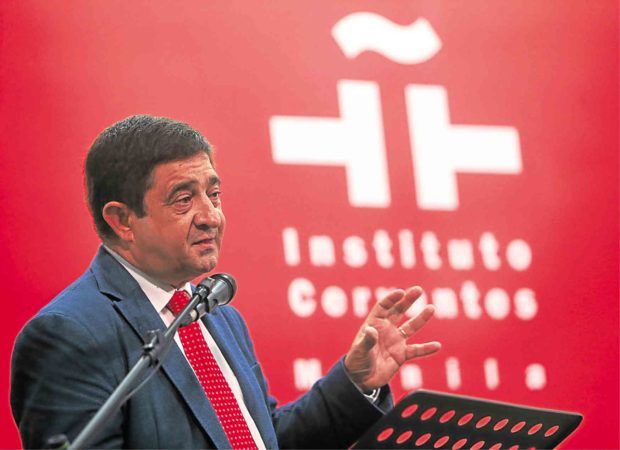
As director general of Instituto Cervantes, the Spanish cultural center that is present in 45 countries around the world, Spanish Deputy Culture Minister Luis García Montero embodies the rich global patrimony of Spanish arts and culture, especially in letters.
Himself a renowned poet, Luis García Montero has earned Spain’s National Poetry Prize and National Poetry Critics Prize for his acclaimed poetry collections, such as “El jardín extranjero,” “Habitaciones separadas,” “La intimidad de la serpiente.” He is also a Literature professor at the University of Granada who has produced scholarly researches on the revolutionary poet Miguel Hernández (1910-1942), after whom the library of Instituto Cervantes in Intramuros is named.
It was because of Hernández that García was in Manila recently.
With Spanish Ambassador Jorge Moragas Sánchez, returning Instituto Cervantes de Manila director Javier Galvan and Francisco Reyes, el presidente or the governor of the Diputacion de (or provincial government of) Jaen, García closed the the Manila leg of the international touring exhibit, “Miguel Hernández: A Plena Luz (In Broad Daylight)” at the Intramuros branch of Instituto Cervantes.
Curated by Juan José Téllez, director of the Centro Andaluz de las Letras, the exhibit opened in Jaen in southeastern Spain in 2017 to mark the 75th death anniversary of Hernández (1910-1942), the bard of the Republican forces who, after the civil war, was arrested by the victorious Nationalist forces under Generalissimo Franco. He later died of tuberculosis in prison.
Hernández as modernist minstrel of the “Vientos del Pueblo (Winds of the People),” as his famous poem about freedom in which he likens the Spanish people not to servile oxen but to defiant, freedom-loving lions, eagles and bulls, has since assumed mythic proportions, rivaling that of the better-known Federico García Lorca, García’s fellow Granadian.
That Hernández upon his death earned the homage of future Nobel laureates—Pablo Neruda of Chile, Vicente Aleixandre of Spain and Octavio Paz of Mexico—should underscore the universal comradeship in excellence and spiritual fire that animates Hispanic language and letters.
The same comradeship was again manifested when García closed the only Asian leg of the international touring exhibit on Miguel Hernández.
“Miguel Hernández is a universal writer for us, and when we named the library in the Philippines [after him], we wanted to pay homage to our historical memory and to offer our poetry to the world,” García told the Inquirer. “We want Miguel Hernández to be known in the Philippines.”
Before the formal closing ceremonies at Instituto Cervantes’ new branch at Casa Azul in Plaza San Luiz across San Agustin Church in Intramuros, García offered a wreath to the monument of José Rizal in Luneta.
Appointed in 2018 to head Instituto Cervantes, García is excited about his job as Spanish cultural ambassador at large.
“In the cultural world, Instituto Cervantes holds much prestige,” he explained. “We have more than 87 centers in 45 countries around the world.”
“I would like to recover the cultural history of Spain and make our people aware of its richness,” said García. “One of the heroes of Philippine independence, José Rizal, wrote in Spanish. I would like that the Spanish people read about José Rizal and consider him a writer in their language, as one of their own.”

“It is the same thing with Latin-American literature—understanding the links and the brotherhood of Spanish and Latin-American writers,” he added. “The great challenge is converting culture into a real force for living together, in Spain and around the world.”
Asia, Latin America
“The mission of Instituto Cervantes is to teach the Spanish language and to disseminate the culture in Spanish,” said García. “Right now, interest in the Spanish language and culture has awakened in Asia. Our most important centers are Beijing, Tokyo, New Delhi and Manila, which for us is the center of Instituto Cervantes’ mission in Asia. It is about creating cultural links between the countries of Asia and Spain, and to serve as a bridge with Latin America.”
There are 483 million speakers of Spanish as a primary language and more than 600 million secondary speakers, said García.
In terms of language instuction enrollment, “Manila is no. 2.”
The growth of the Philippines as a business outsourcing powerhouse means tha t more and more Filipinos are enrolling in Spanish language instruction, especially since United States firms are catering to an ever-growing Hispanic-speaking clientele. (It is said that in a generation, the US president will be Spanish-speaking.)
Of course, Instituto Cervantes is present in the “the 23 countries in which Spanish is the native language,” said García. “Spanish is an incredible language, it has global reach.”
“The great challenge is converting culture into a real force for living together, in Spain and around the world. I believe that investing in culture is investing in democracy and in peace.”
It is in this context that García said Spain needs to recover its “memory… of the Philippines.” It is the same with the Philippines’ memory of its former colonizer.
“Spanish memory could not be properly explained without the presence of the Philippines, and during this trip, I have also confirmed that Philippine memory could not be understood without the presence of Spain,” he explained.
“Fully respecting the independence of both nations and recognizing the fruits of the dialogue between the two nations are, I believe, is fundamental.”
Hernández, Rizal
Literature may enable both countries to recover their shared heritage.
“Spanish literature has always had in mind the Philippines because it has been a part of our history and I would like for Instituto Cervantes to remind Spain of the presence of the Philippines in our history, and for the Philippines, to recall the best of Spanish presence here.”
As a follow-through to the international touring exhibit on Hernández, Francisco Reyes, governor of Jaen, whose provincial government sponsored the exhibit, announced the publication of an anthology that would contain representative poetic works of Hernández and Rizal.
It was the Diputacion de Jaen headed by Reyes that acquired the personal effects and other memorabilia of Hernández from his widow, Josefina Manresa, a Jaen native.

To exhibit the memorabilia, Jaen built the Miguel Hernández Museum that has become a tourist draw.
Jaen’s vast olive fields supply 20 percent of the world’s olive oil requirement and promotion of the legacy of Hernández and other literature-based initiatives should dovetail with Jaen’s drive to become an ecocultural hub, declared Reyes.
Miguel Hernández in fact should appeal to young Filipinos and all the young people of the world.
“[He] is a poet who wrote about love, and love is a timeless theme,” García said. “He is a poet who wrote about freedom, and I think that freedom and a sense of rebelliousness, will always hold importance for the youth.”
“Above all,” the contemporary poet of Granada said, “Miguel Hernández was an author who defended the truth. One of the key themes of his poetry was the truth—being authentic. And in this world which is full of false news, cheating and manipulative information, defending the truth is something… of interest to the youth in any part of the world.”













































